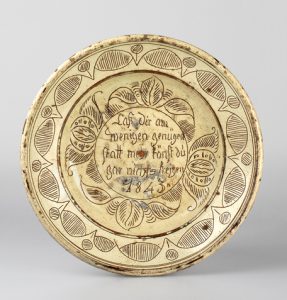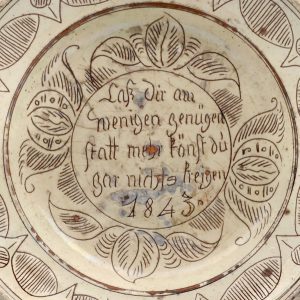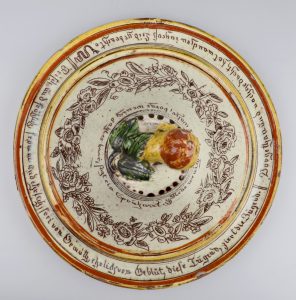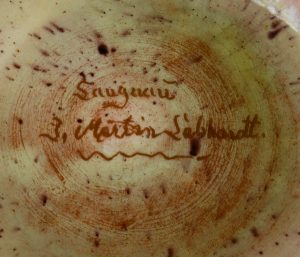



Andreas Heege, 2020
Up to the early 19th century, Swiss pottery bore only monochrome slip (white, red, black-brown, beige), which served as a background colour for different types of decoration (slip trailing, sgraffito, chattering, slip combing etc.).
It was not until the late 1830s that the first examples (plates, tureens) of double-slipped Heimberg-type pottery from the region around Heimberg-Steffisburg, Canton of Bern, were produced. This involved applying a black-brown slip, which was then covered with a coat of white slip. When the decoration was incised or scratched into the slip (sgraffito), the resulting lines were dark in colour; the earlier sgraffito patterns, by contrast, had always been reddish or red because of the colour of the body underneath.

Various workshops from the Heimberg-Steffisburg region used this technique to decorate their wares (Heege/Kistler 2017a, 480-485); one workshop in particular produced very distinctive plates between 1850 and 1870..




Tureen signed by Johann Martin Labhardt, Langnau c. 1850.
With the arrival of Martin Labhardt, a journeyman from Steckborn in the Canton of Thurgau in 1849, the technique also began to be used in Langnau in the Emmental valley of Canton Bern (Langnau workshop 6, potter 22; Heege/Kistler 2017b, 381-386). Later, two other potters at Langnau also used the technique (Langnau workshop 6, potters 24 and 25; Heege/Kistler 2017b, 387-388, Fig. 150).
Translation Sandy Haemmerle
German: Doppelte Grundengobe
French: Décor avec double engobe de fond
References:
Abbitt Outlaw 2002
Merry Abbitt Outlaw, Scratched in Clay: Seventeenth-Century North Devon Slipware at Jamestown, Virginia, in: Ceramics in America, 2002, 17-38.
Heege/Kistler 2017a
Andreas Heege/Andreas Kistler, Poteries décorées de Suisse alémanique, 17e-19e siècles – Collections du Musée Ariana, Genève – Keramik der Deutschschweiz, 17.-19. Jahrhundert – Die Sammlung des Musée Ariana, Genf, Mailand 2017.
Heege/Kistler 2017b
Andreas Heege/Andreas Kistler, Keramik aus Langnau. Zur Geschichte der bedeutendsten Landhafnerei im Kanton Bern (Schriften des Bernischen Historischen Museums 13), Bern 2017.

